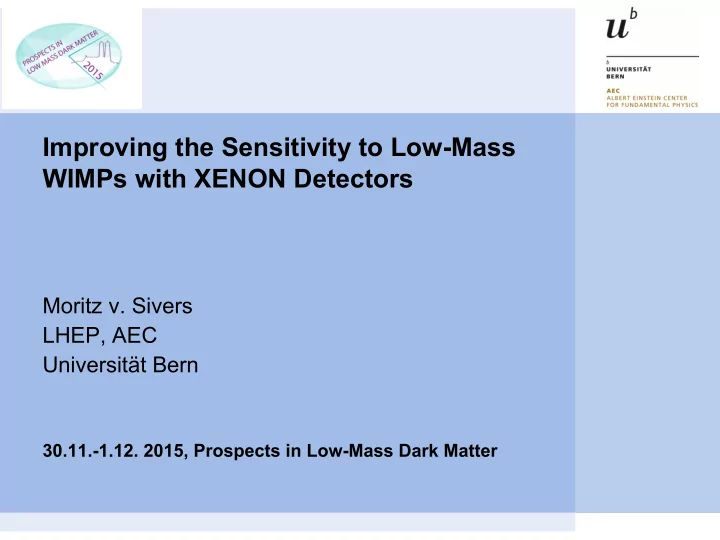

Improving the Sensitivity to Low-Mass WIMPs with XENON Detectors Moritz v. Sivers LHEP, AEC Universität Bern 30.11.-1.12. 2015, Prospects in Low-Mass Dark Matter
Liquid Xenon TPCs > 3D position reconstruction → fiducialization ER/NR discrimination > Removal of double scatters > 2
The XENON1T Experiment Cryogenics & Purification Cryostat 3.5 t LXe DAQ 1 t fiducial ReStoX & Kr Column Water Cherenkov Detector 3
The XENON1T TPC top PMT array diving bell field shaping PTFE reflectors 9 6 rings c m bottom PMT array 96 cm 4
Projected Sensitivity 1.2∙10 -47 cm 2 at 50 GeV after 2 t∙y exposure > 5
Current Status of XENON1T > TPC: Preparation for comissioning and first data Cryogenics: Filling of 3.5 t LXe into ReStoX > 6
Sensitivity to Low-Mass WIMPs High atomic mass of Xe (A=131) ● Energy threshold 3~6 keV ● Currently sensitivity limited to m χ > 6 GeV – Strategies towards lower thresholds ● Increase light collection efficiency (LCE) – XENON100 XENON100 LUX PandaX – Using S2 signal for energy scale arXiv:1509.01515v1 7
What can we do about backgrounds?
Backgrounds > Extensive material screening campaings HPGe detectors – ICP-MS – Rn emanation – GIOVE, MPIK GeMPI, LNGS GeMSE, Bern Gator, LNGS NEW! 9
XENON1T Background > XENON1T: Irreducible background at low energies from CNNS PRELIMINARY 2 t∙y exposure, 3-70 PE 99.75% ER discrimination Total ER 0.76 NR from 0.44 neutrons NR from 0.47 CNNS ~10 keV nr 10
What can we do to improve the LCE?
Light Attenuation Absorption length diminished by H 2 O and O 2 impurities > > Impurity concentration <1ppb reached in XENON100 XENON1T purification system arXiv:physics/0407033 arXiv:1305.0224v1 12
PTFE Reflectors XENON100 XENON1T 13
Electrodes Transparency XENON100 XENON1T Top meshes 47.7% 87.9% Cathode 83.4% 96% XENON1T electrodes Cathode Anode Gate 14
PMTs XENON100 XENON1T PMT Model Hamamatsu R8520-06-Al Hamamatsu R11410 Diameter 1“ 3“ Top array 98 127 Bottom array 80 121 Coverage (bottom array) 52% 76% XENON100 XENON1T PRELIMINARY arXiv:1107.2155v2 15
Light Collection Efficiency L y : Average Light Yield for 122 keV γ at zero field > LCE simulation XENON1T L y (PE/keV) XENON100 3.8 PandaX-I 7.3 LUX 8.8 XENON1T 7.7 (simulation) PRELIMINARY 16
What else can we do to lower the threshold?
„S2-only“ Analysis > Take S2 signal for energy scale Lower threshold from 6.6 keV to ≈1.5 keV – No determination of z-position – No NR/ER discrimination – No background model – arXiv:1104.3088v4 current S1 threshold 100% trigger eff. 18
Single Electron Background > Single electrons generated by photoionization on impurities and metallic surfaces (cathode, field shaping rings) > Peaks at multiples of 20 PE in low-energy S2 spectrum 19
How do we determine the energy scale?
Determining the Energy Scale L eff : Relative light yield of nuclear recoils ● Q y : Charge yield of nuclear recoils ● Currently no published measurements below 3 keV ● arXiv:1304.1427v2 21
XENON100 88 Y/Be Photo-Neutron Source Measurement 152 keV mono-energetic neutrons ● – Nuclear recoils below 4.5 keV Observation of NR events due to Poisson upward fluctuations ● Goal: Decrease uncertainties of L eff /Q y at low energies ● 22
Summary > LXe TPCs have currently best sensitivity for m X > 6 GeV R&D towards lower masses > Increase LCE – „S2-only“ analysis – Requirements > Decreasing uncertainties – in L eff and Q y 23
Backup Slides 24
ER Background XENON1T PRELIMINARY 1 t FV, 2-12 keV Events (y -1 ) Materials 27 ± 3 222 Rn 56 ± 11 85 Kr 28 ± 6 Solar ν 32 ± 1 136 Xe 9 ± 5 25
Trigger Efficiency XENON100 26
XENON1T Energy Scale 27
LCE XENON100 28
Double Photoelectron Emission arXiv:1506.08748v1
Recommend
More recommend